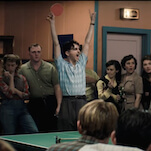Scott Pilgrim is expertly wrought fan service, but it’s also a paean to 8- and 16-bit videogame ephemera, one so dense that it’s easy to count up multiple references to games passed in single screens of the game’s incredibly detailed levels. O’Malley’s comic and Edgar Wright’s movie adaptation are informed by the language and iconography of videogames. Scott Pilgrim Vs. The World: The Game is an allegorical text so dense, it gives Alan Moore’s League of Extraordinary Gentlemen a run for its money. The game’s blink-and-you’ll-miss-it trivia even touches the game’s boot-up screens, with a grainy Universal Pictures logo that could have come out of the Sega Genesis Jurassic Park, alongside a spit-take of arcade-cabinet anti-drug messages.
The game is a beat-’em-up, which only enhances its identity as homage to the best licensed games of the era Scott Pilgrim apes. Multiplayer Konami classics like The Simpsons and X-Men are the inspiration for Pilgrim’s punch-and-kick play, but the game also borrows explicitly from River City Ransom, which lets you build your character’s stats by visiting shops and restaurants. The stat-building component increases the game’s longevity without feeling cheap.
The Ubisoft Montreal team responsible for Pilgrim has a history of making classic brawlers that can be enjoyed by a single player—namely the 2007 cult classic TMNT for Game Boy Advance—but even the character-growth components of this effort can’t make solo play the ideal experience. Scott Pilgrim is best enjoyed with four people playing simultaneously, but without online multiplayer, it may be difficult for folks to enjoy the game properly.
Even for those who aren’t Scott-aholics or retro-game obsessives, Scott Pilgrim is one of the best downloadable games available on home consoles, worth it simply for the solid play, the incredible sprite work from Paul Robertson and Stéphane Boutin, and the bitchin’ soundtrack by Anamanaguchi.







































